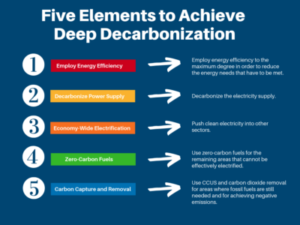This report was prepared by Green Strategies, Inc in conjunction with The NorthBridge Group and the Columbia University Center on Global Energy Policy. See below for the report’s abstract and a downloadable PDF of the full text.
Abstract
By adopting and implementing aggressive renewable energy goals, leading companies have enabled the development of multiple gigawatts (GW) of new renewable generation capacity and demonstrated the ability of corporate buyers to reshape the energy landscape. From 2014 to 2018, large companies announced transactions with off-site renewable energy projects representing over 15 GW of capacity – equal to around one-quarter of all such new renewable generation capacity installed across the country in that same period. This is a great success story.
To achieve mid-century targets for limiting global warming, experts indicate that the U.S. electric grid must achieve full decarbonization by 2050 (if not sooner) – an immense challenge given the current reliance on fossil generators and given the likely future demands for generation arising from the electrification of other sectors. The fastest and most certain pathway to a decarbonized grid is one that utilizes a broad portfolio of zero-carbon resources that can provide firm and dispatchable power to complement intermittent generation. Large energy buyers can accelerate this urgently needed transition to a zero-carbon grid with a new generation of procurement targets and practices. A next generation of goals would prioritize all zero-carbon electricity options, including but not limited to wind and solar, and involve an expanded range of procurement objectives and activities that seek to maximize the carbon impact of procurement and reduce a buyer’s consumption of grid-supplied fossil generation at more times and at more locations.
In this paper, we explore how a “next generation” of corporate electricity procurement strategies and goals could accelerate grid decarbonization to meet science-driven targets. Our analysis covers: A) the imperative of a zero-carbon grid and how a pathway that prioritizes a broad portfolio of zero-carbon generation best aligns with reaching that goal; B) the achievements – and shortcomings – of current corporate renewable energy procurement efforts; C) the possible elements and objectives of next generation corporate procurement strategies; D) example transaction structures for next generation corporate procurements and the potential barriers those transactions might find in today’s marketplace; and E) other challenges corporate buyers might face in adopting and executing next generation goals.
Full Report:
To download, find the download icon on the bottom banner of the embedded PDF.
Green Strategies Report on Next Generation Corporate Procurement - Revised 5-2020
 During these discussions, the group agreed that there are five basic elements necessary to decarbonize the energy system: (1) employ energy efficiency to the maximum degree; (2) decarbonize the electricity supply; (3) electrify other sectors as much as possible, including heat, transportation, and industrial processes; (4) use zero-carbon fuels for the areas that cannot be effectively electrified; and (5) use carbon capture, utilization, and storage (CCUS) and carbon dioxide removal (CDR) for areas where fossil fuels are still needed and for achieving negative emissions.
During these discussions, the group agreed that there are five basic elements necessary to decarbonize the energy system: (1) employ energy efficiency to the maximum degree; (2) decarbonize the electricity supply; (3) electrify other sectors as much as possible, including heat, transportation, and industrial processes; (4) use zero-carbon fuels for the areas that cannot be effectively electrified; and (5) use carbon capture, utilization, and storage (CCUS) and carbon dioxide removal (CDR) for areas where fossil fuels are still needed and for achieving negative emissions.


